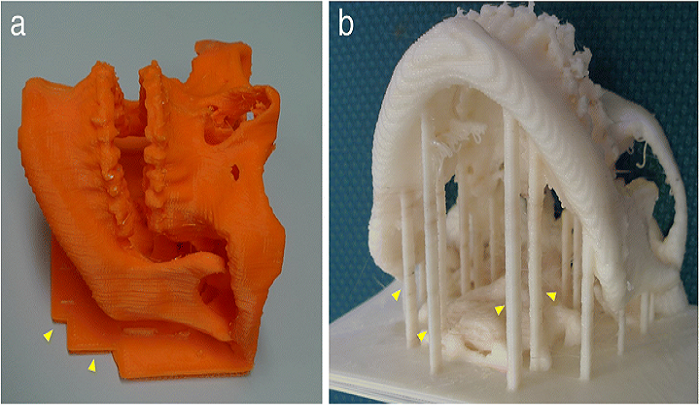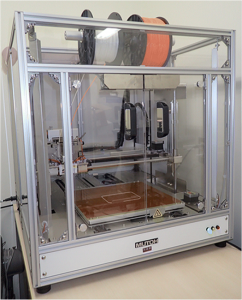
Fabricated PLA 3D models used clinically with a laminating pitch of 0.3 mm and a fill density of 50%.
3D printed patient-specific organ models are used in many areas of medicine for various reasons, including surgical pre-planning, medical training, and providing a better explanation to the patient of what’s going on inside their body. 3D printed models of hard tissues like teeth and bones have been increasing in use in the oral and maxillofacial surgery and dentistry fields, which is a positive thing except for one major drawback – cost. 3D printed models are more expensive than traditionally made medical models, but can the cost be lowered any further?
A group of researchers from Tokyo Dental College
They wrote, “We report our 3D model fabrication environment after determining the dimensional accuracy of the models with different laminating pitches (; layer thickness) after fabricating over 300 3D models. Considerations were made for further reducing modeling cost and model print time. MDCT imaging was performed using a dry human mandible, and 3D CAD data were generated from the DICOM image data. 3D models were fabricated with a fused deposition modeling (FDM) 3D printer MF-2000 (MUTOH) with a laminating pitch of 0.2 mm, 0.3 mm, 0.4 mm, or 0.5 mm. Each 3D model was then subjected to reverse scanning to evaluate the modeling conditions and deformation during modeling. For the 3D image processing system, Volume Extractor 3.0 (i-Plants Systems) and POLYGONALmeister V2 (UEL) were used. For the comparative evaluation of CAD data, spGauge 2014.1 (Armonicos) was used.”
It’s important to lower the cost of these 3D printed models so they can continue to be used as needed. The researchers created their One-Stop 3D printing Lab by generalizing the software and hardware around its inexpensive Value3D MagiX MF-2000 desktop 3D printer from MUTOH Industries Ltd., in order to enable “design, fabrication, and the use of patient-specific 3D models in our facility.”
“3D models were produced quickly and the cost burden was greatly reduced. The laminating pitch (layer thickness) and fill density (infill density) control the amount of modeling material used. While it is expected that an increase in laminating pitch will lead to a reduction in the modeling cost, there is concern that the precision will be lowered,” the researchers wrote.
“As the laminating pitch increased, the weight of the 3D model, model print time, and material cost decreased, and no significant reduction in geometric accuracy was observed.”
3D evaluation software was used to compare the accuracy of the 3D printed mandibular bone models, and rendered positive and negative discrepancies, which can be viewed through color-mapping to determine “specific regions of shape error.”
“Despite the expense, many facilities outsource their 3D modeling to external companies because of the work and time required for their creation,” the researchers wrote. “If inexpensively fabricating medical 3D models were to become possible, more needs could likely be met internally. The costs of the desktop 3D printer and the modeling materials are lower than those of professional 3D printers for industrial use. To promote the spread of 3D printers in the oral and maxillofacial surgery and dentistry fields, it is essential to accumulate knowledge about the modeling characteristics of 3D printers.”
The researchers determined, by 3D printing dental models daily, that the amount of preparation cost and modeling material can be lowered by increasing the laminating pitch.
“In this study, we evaluated the dimensional accuracy of 3D models fabricated with different laminating pitches, aiming for a further reduction of modeling costs. In addition, based on our experience of fabricating over 300 3D models, we report on the “One-stop 3D printing lab” and investigate current problems and future prospects for further utilization of low-cost FDM 3D printers,” the researchers wrote.
“The use of 3D models in the oral and maxillofacial surgery and dentistry fields will likely increase, and we expect that low-cost FDM 3D printers that can produce low-cost 3D models will play a significant role.”

Structures fabricated as support materials (arrowheads). a) To increase the contact area with the heating table of 3D printer, a plate-like support was installed. b) To prevent deformation due to its own weight, a columnar support was installed.
Co-authors of the paper are Takashi Kamio, Kamichika Hayashi, Takeshi Onda, Takashi Takaki, Takahiko Shibahara,
Discuss this research and other 3D printing topics at 3DPrintBoard.com or share your thoughts below.
Subscribe to Our Email Newsletter
Stay up-to-date on all the latest news from the 3D printing industry and receive information and offers from third party vendors.
Print Services
Upload your 3D Models and get them printed quickly and efficiently.
You May Also Like
U.S. Navy Lab Uses 3D Printing to Reduce Tooling Lead Time By Over 90%
The F-35 Lightning II Joint Program Office (JPO), responsible for life-cycle management of the key fifth-generation joint strike fighter (JSF) system used by the U.S., its allies, and its partners,...
Etsy Design Rule Change Reduces Selection of 3D Printed Goods
Online marketplace Etsy has implemented a rule change requiring all 3D printed goods on the site to be original designs. The update to the site’s Creativity Standards states, ¨Items produced using...
Honeywell Qualifies 6K Additive’s Nickel 718 for 3D Printed Aerospace & Defense Parts
6K Additive is renowned for manufacturing sustainable additive manufacturing (AM) powder, and offers a wide portfolio of premium metal and alloy powders that include titanium, copper, stainless steel, and nickel,...
MetalWorm Sells WAAM Systems to Research Institutes in Brazil and Malaysia
Turkish WAAM firm MetalWorm has sold a system in Malaysia and another in Brazil. This is an excellent example of a few emerging trends in additive. Firstly, WAAM was experimented...



































